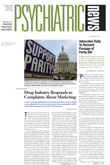It can strike anywhere, any time—that pounding, throbbing headache that brings daily activities to a complete stop and can last anywhere from four to 72 hours.
But what sets migraine headaches apart from, for example, the more common tension headache is its severity, its tendency to produce nausea or vomiting, and the sufferer’s sensitivity to physical movement, light, and sound, said Stephen Silberstein, M.D., at APA’s 2002 annual meeting in Philadelphia in May.
“Migraines restrict people’s ability to function in daily activities, resulting in lost economic, social, and educational opportunities,” said Silberstein, who is a professor of neurology and directs the Jefferson Headache Center at Thomas Jefferson University Hospital in Philadelphia.
Migraine headaches have a prodromal and a postheadache period. The prodromal signs may include short-acting depression, irritability, euphoria, restlessness, sensitivity to odors, difficulty concentrating, sluggishness, and food cravings, he said.
When the migraine ends, patients often feel exhausted and may have impaired concentration, muscle aches, and occasionally mild mania, said Silberstein.
What Are Migraines?
A migraine is a neurological disorder that begins when blood vessels to the head constrict. This triggers various symptoms, ranging from visual, sensory, or motor distortions (aura) to a headache. The constricted blood vessels then overcorrect by dilating, which causes an increase in blood flow to the head. It is this increased flow of blood into the head in a short period that triggers a full-blown migraine.
The aura can occur even without a headache, said Silberstein. The aura symptoms typically develop in five to 20 minutes and last less than an hour. Common visual symptoms include flashing lights, blind spots that move across the visual field, and blind spots shaped liked jagged crescents called “fortification spectra,” all of which can temporarily obstruct a person’s vision, said Silberstein.
Hallucinations can also occur with migraines. Lewis Carroll, the author of Alice in Wonderland, is believed to have had migraine attacks that inspired his writing, said Silberstein.
Migraines affect roughly 28 million Americans, three times as many women as men, and they can begin in childhood.
Psychiatric Comorbidity
Migraines are frequent in people with mood disorders, said Silberstein. Researchers have found that people with major depression are three times more likely to have migraines than the general population, and people with migraines are three times more likely to develop major depression than the general population.
Panic attacks are another risk factor for developing migraines. Migraines are a risk factor for developing social phobia, generalized anxiety disorder, and bipolar disorder, he added.
Despite the strong link to mental illness, most psychiatric patients fail to mention that they have headaches or migraines unless they are asked, said Silberstein.
For moderate to severe headaches, Silberstein’s first choice of medications is the triptans, including sumatriptan, zolmitriptan, and rizatriptan, followed by ergotamine and, lastly, analgesics.
Silberstein cautioned that triptans, which are selective serotonin receptor agonists, are contraindicated in people who have frequent headaches and/or who have cardiovascular disease, because they prolong the constriction of the blood vessels. Similarly, for patients who experience an aura with their migraines, triptans are likely to prolong the aura, but they do prevent the full-blown headaches.
The use of these medications should be monitored carefully to avoid overuse, which can cause intractable headaches, said Silberstein. Overuse occurs when the patient takes simple analgesics on a daily basis, combination analgesics or triptans more than three times a week, or ergotamine tartrate or opioids more than twice a week, said Silberstein.
He recommended that physicians discontinue the overused medication before trying new medications. “But be aware that the patient’s symptoms, including headaches, may worsen before improving,” he warned.
“My observation has been that analgesic overuse is one of the causes of refractory depression, and when the headaches improve, often so does the psychiatric condition,” said Silberstein.
The first step in making a diagnosis is ruling out secondary causes, such as brain tumors and meningitis. “Be careful not to assume that the treatment response establishes a diagnosis.” For example, Silberstein explained that he saw a patient in the emergency room who was responding to triptans based on a diagnosis of migraine, but who actually had a subarachnoid hemorrhage.
Treating Comorbid Conditions
Medication overuse can be a form of self-treatment for a comorbid mood disorder, said Silberstein. For example, patients with bipolar disorder may overmedicate themselves with a caffeine-barbiturate combination to treat their mood disturbance.
Once the comorbid disorder is correctly diagnosed, one medication can often be used to prevent recurrent migraines and treat the psychiatric disorder, said Silberstein. For example, divalproex can be used to treat mania, anxiety disorders, and migraines. The tricyclic antidepressants amitriptyline and nortriptyline are effective in treating migraines and depression, anxiety disorders, and insomnia. Selective serotonin reuptake inhibitors (SSRIs) are used to treat depression and migraines, although there is less research on their efficacy for migraines.
Beta-blockers should not be used to treat migraines in people with depression, and SSRIs are contraindicated in people with mania, said Silberstein.
Patients who experience migraines can also benefit from psychotherapy, such as cognitive-behavioral therapy and relaxation techniques, including biofeedback, he noted.
The “Evidence-Based Practice Guidelines for Migraine Headache” is posted on the Web site of the American Academy of Neurology at www.aan.com/public/practiceguidelines/headache_gl.htm. Additional information is posted on the Web site of the National Headache Foundation at www.headaches.org. ▪
